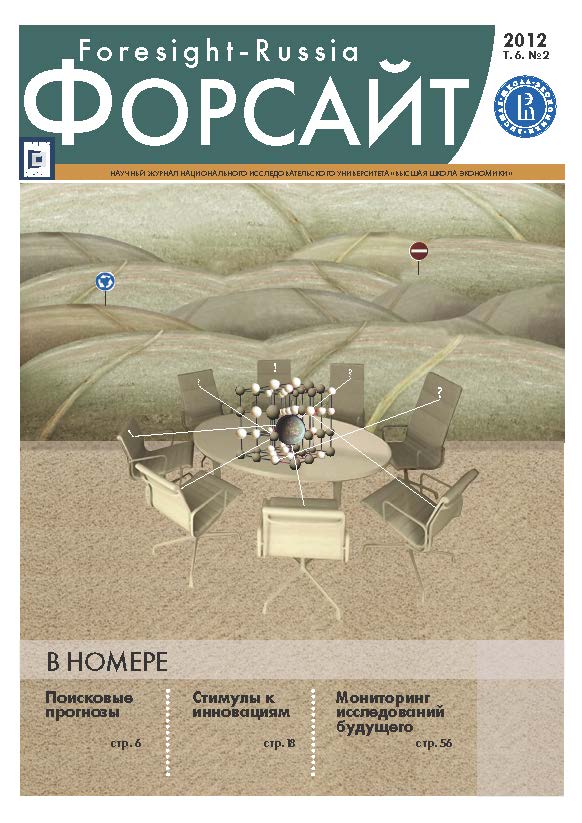Abstract
Technology roadmaps are typically used in terms of normative approach to long-term S&T forecasting thus serving as a visual tool to identify optimal ways to reach defined future goals. Nonetheless roadmaps can be applied to exploratory studies as well. The latter are aimed at identifying key potentially transformative events, whose dynamics could be influenced by a wide range of externalities. Trends in some fields appear to dominate and shape movement in other areas. Roadmapping allows visualizing and assessing probabilities of cross-impact between various areas of forecasting thus identifying possible scenario bifurcations as well as new risks and opportunities. This paper describes the exploratory roadmap being developed for the Russian Long-Term S&T Foresight 2030. According to that roadmap, evolution to 2020 closely follows macroeconomic trends. However, in regard to technological development, either the «rapid inflation» scenario or the «gradual way out of the crisis» one, the rate is the same, in our view. After 2020, the dominating role in evolution is expected to shift to «global technologies».
These technologies are grouped into six thematic areas according to countries’ S&T priorities, i.e. energy, transport, information and communications technologies (ICTs), medicine, nanotechnologies, and production systems. The most influential scenario bifurcation in the roadmap emerges from the field of energy. Depending on the actual scenario — «the expansion of alternative energy sources» or «the widespread use of non-conventional hydrocarbon fuels» — the global economy will experience rapid growth or slow stagnation respectively.
References
BMBF (2010) Ideas. Innovation. Prosperity. High-Tech Strategy 2020 for Germany. Federal Ministry of Education and Research.
CAS (2010) Science & Technology in China: A Roadmap to 2050 (Strategic General Report). The Chinese Academy of Sciences.
EIRMA (1997) Technology roadmapping -delivering business vision. Working group report № 52. Paris: European Industrial Research Management Association.
Garcia M.L., Bray O.H. (1997) Technology roadmapping: the integration of strategic and technology planning for competitiveness. Paper presented at the Portland International Conference on Management of Engineering and Technology (PICMET), July 27-31.
Groenveld P. (1997) Roadmapping Integrates Business and Technology//Research-Technology Management. Vol. 40. № 5. P. 48-55.
Kostoff R.N., Schaller R.R. (2001) Science and technology roadmaps//IEEE Transactions of Engineering Management. Vol. 48. № 2. P. 132-143.
MESR (2010) National Research and Innovation Strategy. Ministry for Higher Education and Research, France.
NEC, CEA, OSTP (2011) A Strategy for American Innovation. Securing Our Economic Growth. National Economic Council, Council of Economic Advisers, Office of Science and Technology Policy.
NESTA (2009) Demanding Growth. Why the UK Needs a Recovery Plan Based on Growth and Innovation.
Revitalizing Japan (2010) On the New Growth Strategy. Blueprint for Revitalizing Japan. Cabinet Decision.
Strauss J.D., Radnor M. (2004) Roadmapping for dynamic and uncertain environments//Research Technology Management. Vol. 47. № 2. P. 51-57.
Безносюк М. (2012) Резкая посадка//CleanTech. № 9(4), зима 2011-2012. http://novostinauki.ru/news/43118/.
Карасев О.И. (2009) Методология разработки технологических дорожных карт. http://cert-energy.ru/doc/rm/1/Karasev.pdf.
Лидин К.Л. (2006) Многообразие построения дорожных карт. www.virtass.ru/IO/14_5.doc.
ФЦП (2011) Федеральная целевая программа «Ядерные энерготехнологии нового поколения на период 2010-2015 годов и перспективу до 2020 года» (в ред. постановления Правительства РФ № 135 от 01.03.2011).

This work is licensed under a Creative Commons Attribution 4.0 International License.

